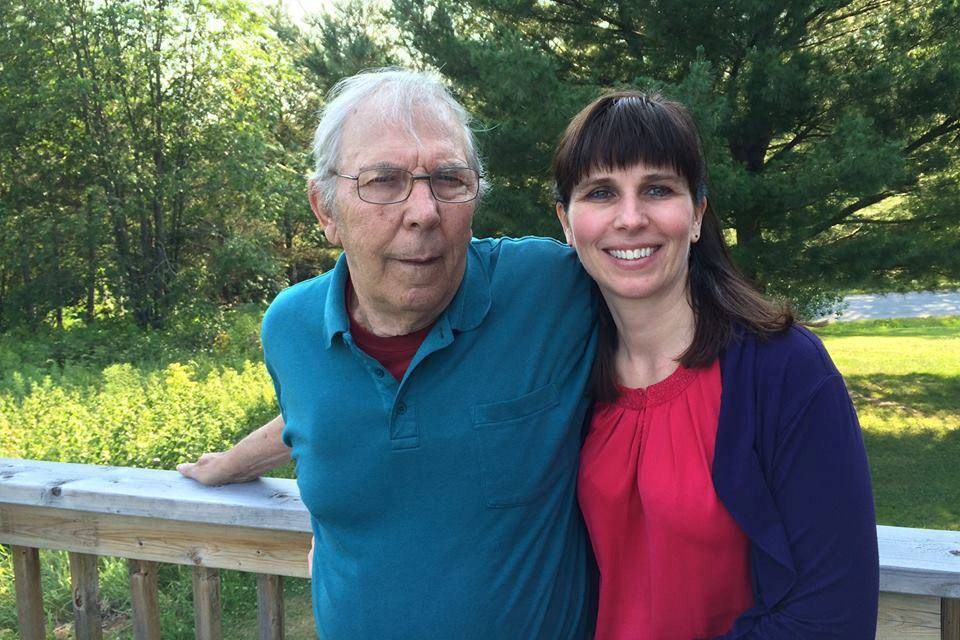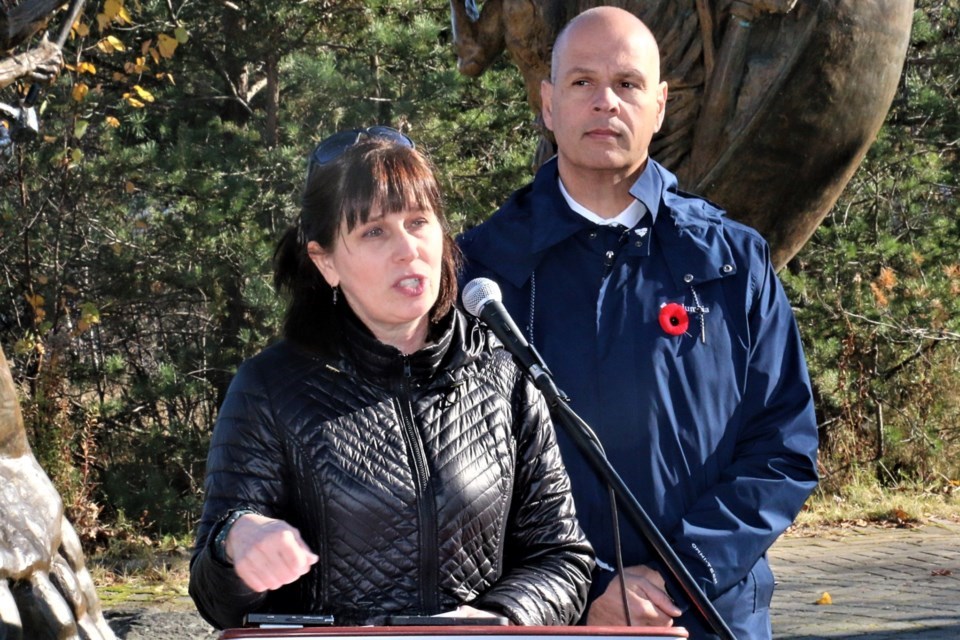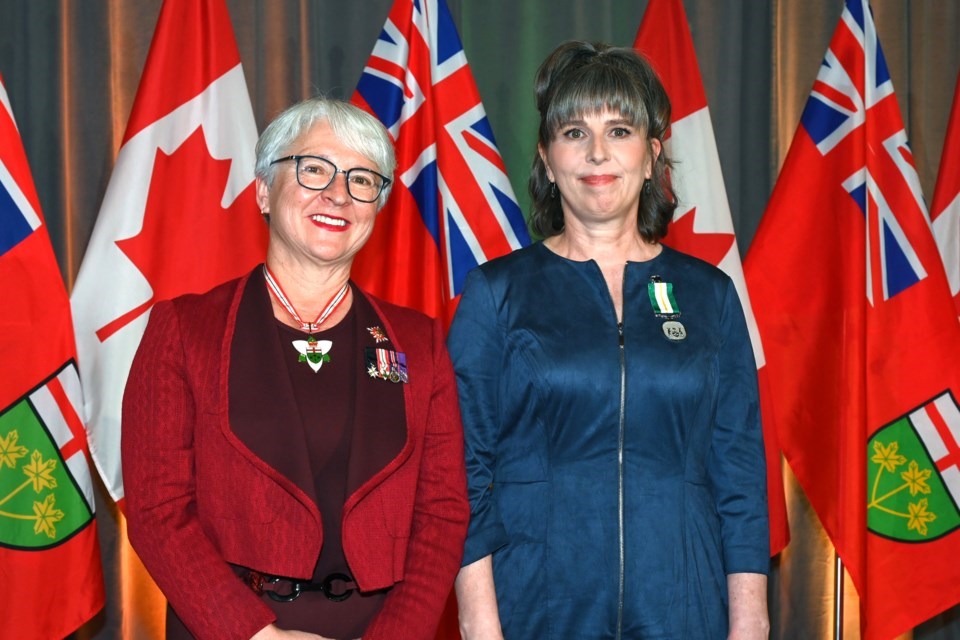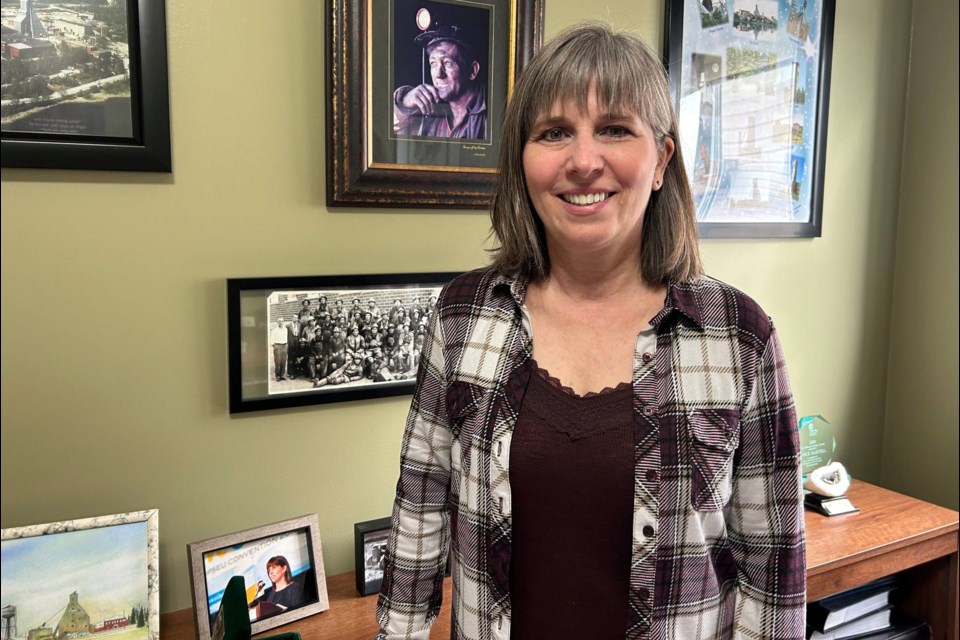Glancing around her Sudbury home office, Janice Hobbs Martell can trace the evolution of her advocacy work on behalf of Northern Ontario miners based on the mementos she’s collected over the years.
There’s the group photo of retirees taken in Timmins during a recent Pamour Mine reunion. An original piece of artwork, painted by a miner’s daughter, presented to her in gratitude. The framed newspaper article outlining her advocacy work. An image of Hobbs Martell herself, speaking at an event hosted by the Ontario Public Service Employees Union.
Each piece in her collection holds deep, personal meaning.
The most recent addition, nestled in a small, green velvet box, sits atop a bookcase neatly lined with dozens of binders containing years’ worth of research.
Presented by the provincial government, the Ontario Medal for Good Citizenship acknowledges those who have spent a lifetime dedicated to noble causes, leaving a positive imprint in their communities and across the province.
It’s one of the highest honours an Ontario citizen can receive, second only to the Order of Ontario.
Hobbs Martell travelled to Toronto on March 10 to accept her medal, in a ceremony led by Lieutenant General Edith Dumont, alongside 10 other worthy recipients, with her husband, daughter and son proudly looking on.
“It was important to me that they were there, because this kind of work takes away my focus and time and energy and finances,” said Hobbs Martell, reflecting on the experience, which she described as profoundly meaningful.
“So I think it was important, for me, for them to see that.”

Since her dad, Jim Hobbs, first shared his experience of inhaling aluminum dust known as McIntyre Powder — while working as a miner at the Quirke II uranium mine in Elliot Lake in the 1970s — Hobbs Martell has made it her life’s work to find answers about how such a practice could happen.
This April marks the 10th anniversary since she publicly launched the McIntyre Powder Project, a volunteer registry of miners who were forced to inhale the powder as a condition of work, later developing a range of respiratory, neurological and cardiovascular illnesses.
SEE: Project documents impacts from aluminum powder in miners
To date, 700 miners have agreed to be part of the project — a remarkable participation rate that is still just a fraction of the thousands of industrial workers around the world that were impacted by the government-sanctioned practice, which ran from 1943 to 1979/1980.
Of those, 382 are deceased, some of whom have died during the course of the project. It hurts every time she loses another one.
“I’ve heard a lot of stories, and it weighs on me,” Hobbs Martell said.
The miners on her list have suffered or are suffering. From Alzheimer’s disease, amyotrophic lateral sclerosis (ALS), chronic pulmonary obstructive disease, silicosis, sarcoidosis, pulmonary fibrosis, cardiovascular illness, and a range of cancers.
Her dad was diagnosed with Parkinson’s disease — one of 71 on her registry — and died of the illness in 2017.
It was the initial denial by the Workplace Safety and Insurance Board (WSIB) of his claim for workers compensation that first drove Hobbs Martell to take on this crusade, and it was the hundreds of similar stories that propelled her to keep going.
She wasn’t sure she would be successful in her quest for answers, but she knew she had to try.
“You know, I’m pretty stubborn. I was pretty sure that I was going to keep going until something happened,” she laughed.
“But it’s important to try, and it’s important to show these workers that they are important, their life history and their life experience, and their lived experience with these diseases and illness, and the way that they were treated in the mines.”
SEE: Miners recall use of black powder during employment
She’s spent thousands of hours of personal time interviewing miners and their families, researching McIntyre Powder and its origins, and hosting information sessions in mining towns across the North. She’s met with legislators, organized presentations, made phone calls, filled out forms, given media interviews, and reviewed complex medical data. She’s worn out three printers and blazed through countless ink cartridges.
“I think when I started out, I wanted the answer,” Hobbs Martell said. “I felt helpless with dad.”

Because of her efforts, the WSIB in 2020 found a definitive link between the inhalation of McIntyre Powder and the onset of Parkinson’s disease.
That led to the organization formally recognizing a diagnosis of Parkinson’s disease linked to work-related exposure to McIntyre Powder as an occupational disease under the Workplace Safety and Insurance Act.
Later that year, the province gave an official apology in the Legislative Assembly for the role it played in allowing McIntyre Powder to be used on miners.
Her dad’s WSIB claim was finally approved in 2020 after the WSIB ruling. Hundreds of other miners and their families have received compensation, thanks to Hobbs Martell raising the alarm about McIntyre Powder, easing some of the financial burden that comes with serious, chronic illness.
“The health-care benefits can be life-changing, and the survivor benefits are absolutely life-changing,” Hobbs Martell said.
“They allow widows to have a life and not lose their home and lose their way of life.”
But for many of those affected, she said “it’s the acknowledgement” of what happened to them that carries special significance.
With as much as she’s achieved, she believes there’s still a lot of work to do related to occupational disease in this country.
Many of the miners in her registry are elderly and aren’t adept at filling out complex paperwork, or even knowing who to call to start the process.
She remains critical of the WSIB and its new, rapid review system that aims to assess more workplace compensation claims faster. Hobbs Martell believes these rapid reviews make it much easier to deny claims.

Her ultimate dream is for Canada to have a national registry for occupational disease.
If workers’ health histories could be tracked in a central database and matched up with exposures in the workplace, it would be much easier to identify toxic substances and eliminate them, she reasoned.
But it would require consistent political will to achieve something like this, and sadly, she said, she doesn’t think it’s a priority in this country.
“There are going to be things that we don't know are toxic until we've seen evidence over years and years, right? But at least you're going to catch that, and then you can make changes,” she said.
“There are things that we've known for years and years are toxic. We can change those now. We should be able to reduce silica dust, reduce diesel exhaust. Those are two big ones.”
SEE: Clinic telling stories of miners and aluminum powder
She remains focused on doing whatever's needed — sharing information, rallying support, lobbying politicians — to help as many McIntyre Powder miners and families as she can.
She’s also made arrangements for her website, which outlines her work and the history of McIntyre Powder, to carry on when she’s no longer able to do it.
“It’s not a pretty website, by any means, but it has really good information about this, to help people, and I want people to have that after I’m gone,” she said.
Fairly soon, Hobbs Martell will have to make room in her office for one more award: in May, she’ll receive the Mining Safety Leadership Medal from the Canadian Institute of Mining, Metallurgy and Petroleum (CIM) during the organization’s annual conference in Montreal.
First given in 2018, the Mining Safety Leadership Medal is bestowed “for exceptional contribution towards improving mining health and safety results within the mining industry in Canada.”

Hobbs Martell will be the first person from outside the sector to receive the award, and she’s honoured to be selected. But getting these commendations stirs conflicting emotions.
It’s validating that, after all these years, government and industry are acknowledging her work and, with that, recognizing the wrongdoing by the mine executives and complicit governments that caused decades of harm.
At the same time, her motivation has never been the accolades — Hobbs Martell’s priority has always been to get justice for her dad and the other affected men whom she affectionately calls “my miners.”
So, in preparation for the CIM event next month, she’s found a way to alleviate some of her discomfort around the personal attention her advocacy brings.
As part of her outfit for the awards gala, Hobbs Martell will wear a shawl that she’s had custom-printed with photos of many of the miners who are included on her registry.
In that way, they will be there with her, even if in spirit only.
“It feels weird to get an award when I know how much suffering there’s been for these guys and that they’re not there,” she said.
“And I thought that was just a way that I could bring them with me, and then I felt like, ‘OK. I can go get this.’”




